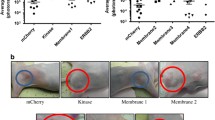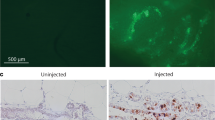Abstract
Fischer rat FR3T3 cells were tested for tumorigenicity, invasive and metastatic capabilities before and after transfection, either with the entire bovine papilloma virus type 1 (BPV-1) genome or with a plasmid (pV69) containing a 69 per cent Bam H1-Hind III fragment of the BPV-1 genome as well as bacterial sequences. Cell lines were grouped as parental, pV69-transfectants, BPV-1 transfectants,in vitro derivatives, andin vivo derivatives. The tumorigenic, invasive and metastatic capabilities of these cell lines were examinedin vivo through s.c., and i.p. injections of cell suspensions and through s.c. implantations of cellular aggregates into syngeneic rats. Invasiveness was testedin vitro through confrontations with embryonic chick heart fragments in organ culture. All cell lines including parental lines, were found to be invasivein vitro and tumorigenicin vivo; all tumors were invasive. It is, therefore, not possible to draw conclusions about the role of BPV-1 gene sequences in the acquisition of the invasive phenotype. Transfection with BPV-1 genes conveyed the metastatic phenotype upon parental FR3T3 cells, which were themselves found to be non-metastatic. With regards to this, no differences were found between BPV-1 transfectants compared with pV69 transfectants. Untransfected cells became metastatic also through passagein vivo as an s.c. tumor. The expression of the metastatic phenotype was not noticeably correlated with alterations of growth characteristics of the cell lines. We concluded that the implication of BPV-1 gene sequences in conveying the metastatic phenotype upon FR3T3, if any, was indirect, presumably through alterations of the host cell genome. Our experiments illustrate the need for long-term observations with parental cell lines before drawing conclusions about the role of oncogenes in the acquisition of the malignant phenotype.
Similar content being viewed by others
References
Androphy, E. J., Lowy, D. R., andSchiller, J. T., 1987, Bovine papillomavirus E2 trans-activating gene product binds to specific sites in papillomavirus DNA.Nature,325, 70–73.
Androphy, E. J., Schiller, J. T., andLowy, D. R., 1985, Identification of the protein encoded by the E6 transforming gene of bovine papilloma virus.Science,230, 442–445.
Attia, M. A. M., andWeiss, D. W., 1966, Immunology of spontaneous mammary carcinomas in mice. V. Acquired tumor resistance and enhancement in strain A mice infected with mammary tumor virus.Cancer Research,26, 1787–1800.
Babiss, L. E., andFisher, P. B., 1986, Characterization of Fischer rat embryo (CREF) cells transformed by bovine papillomavirus type 1.Virology,154, 180–194.
Binetruy, B., Meneguzzi, G., Breathnach, R., andCuzin, F., 1982, Recombinant DNA molecules comprising bovine papilloma virus type 1 DNA linked to plasmid DNA are maintained in a plasmidial state both in rodent fibroblasts and in bacterial cells.EMBO Journal,5, 621–628.
Bishop, J. M., 1987, The molecular genetics of cancer.Science,235, 305–311.
Boghaert, E. R., Distelmans, W., Van Ginckel, R., andMareel, M. M., 1987, Numerical evaluation of the kidney invasion test.Invasion and Metastasis,7, 230–241.
Bracke, M. E., Van Cauwenberge, R. M.-L., andMareel, M. M., 1984, (+)-Catechin inhibits the invasion of malignant fibrosarcoma cells into chick heartin vitro.Clinical and Experimental Metastasis,2, 161–170.
Broker, T. R., andBotchan, M., 1986, Papillomaviruses: retrospectives and prospec- tives.Cancer Cells 4. DNA Tumor Viruses. (Cold Spring Harbor, NY: Cold Spring Harbor Laboratory), pp. 17–36.
Cajot, J.-F., Sordat, B., andBachmann, F., 1986, Human primary colon carcinomas xenografted into nude mice. II. Modulation of tumor plasminogen activator activity by the host tissue environment.Journal of the National Cancer Institute,77, 1099–1107.
Cuzin, F., 1984, The polyoma virus oncogenes. Coordinated functions of three distinct proteins in the transformation of rodent cells in culture.Biochimica et Biophysica Acta,781, 193–204.
Cuzin, F., Meneguzzi, G., Binetruy, B., Cerni, C., Connan, G., Grisoni, M., andDe Lapeyriere, O., 1985, Stepwise tumoral progression in rodent fibroblasts transformed with bovine papilloma virus type 1 (BPV1) DNAPapillomaviruses: Molecular and Clinical Aspects, edited by P. M. Howley and T. R. Broker (New York: Alan R. Liss, Inc.), pp. 473–486.
De Baetselier, P., Roos, E., Brys, L., Remels, L., Gobert, M., Dekegel, D., Segal, S., andFeldman, M., 1984, Nonmetastatic tumor cells acquire metastatic properties following hybridization with normal cells.Cancer Metastasis Reviews,3, 5–24.
De Lapeyriere, O., Arnaud, D., Courcoul, M., Planche, J., Meyer, G., andBirg, F., 1986, Polyomavirus-transformed FR3T3 rat cells are able to form metastases in syngeneic rats.Virology,148, 146–158.
Gao, J., Van Roy, F., Messiaen, L., Cosaert, J., Liebaut, G., Coopman, P., Fiers, W., andMareel, M., 1987, Pathology of tumours produced in syngeneic Fischer rats by fibroblast-like cells before and after transfection with oncogenes.Pathology, Research and Practice,182, 48–57.
Giri, I., andDanos, O., 1986, Papillomavirus genomes: from sequence data to biological properties.Trends in Genetics,2, 227–232.
Grisoni, M., Meneguzzi, G., De Lapeyriere, O., Binetruy, B., Rassoulzadegan, M., andCuzin, F., 1984, The transformed phenotype in culture and tumorigenicity of Fischer rat fibroblast cells (FR3T3) transformed with bovine papilloma virus type 1.Virology,135, 406–416.
Gross, L., 1981, Bovine papillomas.Oncogenic Viruses, volume 1 (3rd edition) (London: Pergamon Press), pp. 63–70.
Lacey, M., Alpert, S., andHanahan, D., 1986, Bovine papillomavirus genome elicits skin tumours in transgenic mice.Nature,322, 609–612.
Lancaster, W. D., andOlson, C., 1982, Animal papillomaviruses.Microbiological Reviews,46, 191–207.
Land, H., Parada, L. F., andWeinberg, R. A., 1983, Tumorigenic conversion of primary embryo fibroblasts requires at least two cooperating oncogenes.Nature,304, 596–601.
Lusky, M., andBotchan, M. R., 1986, Transient replication of bovine papilloma virus type 1 plasmids:cis andtrans requirements.Proceedings of the National Academy of Sciences, U.S.A.,83, 3609–3613.
Mareel, M. M., Bruyneel, E. A., De Bruyne, G. K., Dragonetti, C. H., andVan Cauwenberge, R. M.-L., 1982, Growth and invasion: separate activities of MO4 cell populationsin vitro.Membranes in Tumour Growth, edited by T. Galeottiet al. (Amsterdam: Elsevier Biomedical Press), pp. 223–232.
Mareel, M. M., De Bruyne, G. K., Vandesande, F., andDragonetti, C., 1981, Immunohistochemical study of embryonic chick heart invaded by malignant cells in three-dimensional culture.Invasion and Metastasis,1, 195–204.
Mareel, M., Kint, J., andMeyvisch, C., 1979, Methods of study of the invasion of malignant C3H mouse fibroblasts into embryonic chick heartin vitro.Virchows Archiv B Cell Pathology,30, 95–111.
Mareel, M. M., andVan Roy, F. M., 1986, Are oncogenes involved in invasion and metastasis?Anticancer Research,6, 419–436.
Mareel, M., Van Roy, F., Bruyneel, E., Bolscher, J., Schallier, D., andDe Mets, M., 1987 a, Molecular biology of minimal invasion.Recent Results in Cancer Research: Minimal Neoplasia, vol. 106, edited by E. Grundmann and L. Beck (Berlin-Heidelberg: Springer-Verlag), pp. 14–20.
Mareel, M.,Coopman, P.,Dragonetti, C.,Fiers, W.,Gao, J.,Messiaen, L., andVan Roy, F., 1987b, Spontaneous and oncogene-mediated acquisition of the invasive phenotype by cells in culture.Journal of Cellular Biochemistry, (in press).
Meneguzzi, G., Binetruy, B., Grisoni, M., andCuzin, F., 1984, Plasmidial maintenance in rodent fibroblasts of a BPV1-pBR322 shuttle vector without immediately apparent oncogenic transformation of the recipient cells.EMBO Journal,3, 365–371.
Meyvisch, C., 1983, Influence of implantation site on formation of metastases.Cancer Metastasis Reviews,2, 295–306.
Meyvisch, C., andMareel, M., 1982, Influence of implantation site of MO4 cell aggregates on the formation of metastases.Invasion and Metastasis,2, 51–60.
Meyvisch, C., andMareel, M., 1985, Site-induced differences in spontaneous metastasis of MO4 mouse fibrosarcoma cells.Invasion and Metastasis,5, 185–192.
Nasseri, M., Wettstein, F. O., andStevens, J. G., 1982, Two colinear and spliced viral transcripts are present in non-virus-producing benign and malignant neoplasms induced by the Shope (rabbit) papilloma virus.Journal of Virology,44, 263–268.
Phelps, W. C., Leary, S. L., andFaras, A. J., 1985, Shope papillomavirus transcription in benign and malignant rabbit tumors.Virology,146, 120–129.
Pozzatti, R., Muschel, R., Williams, J., Padmanobhan, R., Howard, B., Liotta, L., andKhoury, G., 1986, Primary rat embryo cells transformed by one or two oncogenes show different metastatic potentials.Science,232, 223–227.
Sarver, N., Rabson, M. S., Yang, Y.-C., Byrne, J. C., andHowley, P. M., 1984, Localization and analysis of bovine papillomavirus type 1 transforming functions.Journal of Virology,52, 377–388.
Schlegel, R., Wade-Glass, M., Rabson, M. S., andYang, Y. C., 1986, The E5 transforming gene of bovine papillomavirus encodes a small, hydrophobic polypeptide.Science,233, 464–467.
Seif, R., andCuzin, F., 1977, Temperature-sensitive growth regulation in one type of transformed rat cells induced by the tsa mutant of polyoma virus.Journal of Virology,24, 721–728.
Van Roy, F. M., Messiaen, L., Liebaut, G., Gao, J., Dragonetti, C. H., Fiers, W. C., andMareel, M. M., 1986, Invasiveness and metastatic capability of rat fibroblast-like cells before and after transfection with immortalizing and transforming genes.Cancer Research,46, 4787–4795.
Walsh, J. W., Zimmer, S. G., Oeltgen, J., andMakesbery, W. R., 1986, Invasiveness in primary intracranial tumors: part 1. An experimental model using cloned SV-40 virus-produced hamster brain tumors.Neurosurgery,19, 185–200.
Author information
Authors and Affiliations
Rights and permissions
About this article
Cite this article
Coopman, P., Van Roy, F., Dragonetti, C. et al. Tumorigenicity, invasiveness and metastatic capability of FR3T3 rat cells before and after transfection with bovine papilloma virus type 1 DNA. Clin Exp Metast 7, 69–84 (1989). https://doi.org/10.1007/BF02057182
Received:
Accepted:
Issue Date:
DOI: https://doi.org/10.1007/BF02057182




